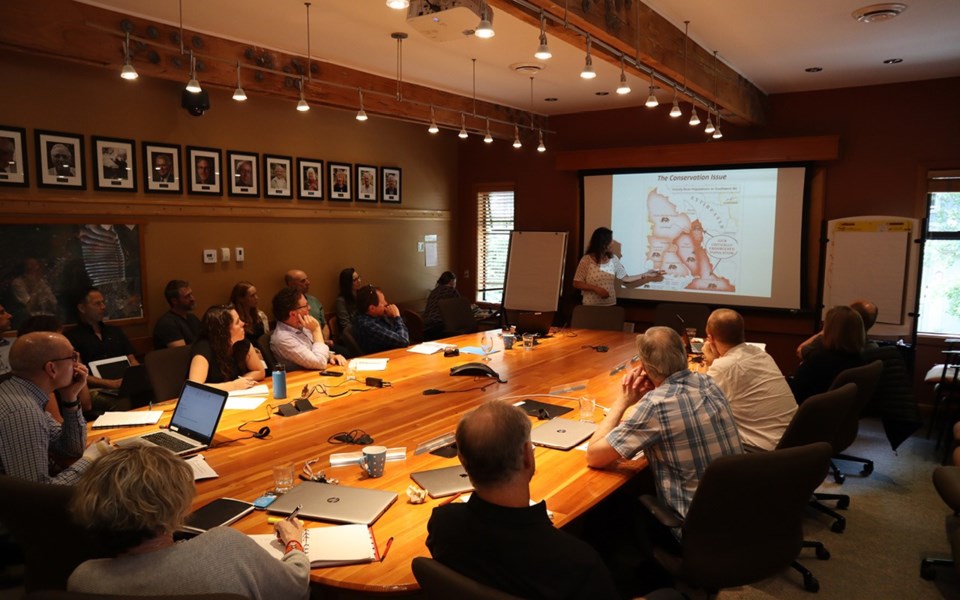While the expansion of Whistler's Alpine Trail Network into the Sproatt and Rainbow Mountain area was preceded by a grizzly bear risk assessment and conflict management strategy, an independent review of both documents by a renowned grizzly expert found some big, unanswered questions.
"Neither of the documents that I read question the effects of the expansion of recreation on grizzly bear habitat or discuss the implication of this increased network on grizzly bears and the conservation of grizzly bears," said Dr. Lana Ciarniello, in a presentation to Whistler's Committee of the Whole on May 28. "They don't ask that question."
The Squamish-Lillooet Grizzly Bear Population Unit (within which the Sproatt/Rainbow trails are located) is still considered "threatened," with about 12 bears per 1,000 square kilometres (about half its carrying capacity).
Grizzly sightings on the alpine trails (opened in 2017) started to become more common late in the summer last year, and the Resort Municipality of Whistler (RMOW) closed the trails to the public in September.
Since opening, the trails have seen about 2,500 users a month from summer to fall, for a total of about 14,000 users every year.
"That is extremely high. That is very, very high in bear habitat," said Ciarniello, one of Canada's leading bear experts with the International Union for Conservation of Nature.
But the impact on grizzly habitat is not the only thing missing from the studies, Ciarniello said, adding that, though grizzly bears in southwestern B.C. are some of the most-researched bears in the province, the reports don't make use of the data.
"We know a lot about these bears. We have DNA on every bear in the Stein-Nahatlatch ... but there's not a mention of it. There's not even a report in here," she said. "You have so much information on this population, yet, one of the only things that was in here was that the bears are feeding on salmon, and so they'll come down low."
And even that detail isn't accurate, Ciarniello said, noting that, in the case of females (which are crucial to sustaining the population), they typically stay high, feeding on blueberries and the "extremely fatty" seeds of the whitebark pine, which are linked to reproduction.
And if the reports are based on the assumption that the grizzlies are staying low in the valley, how does that affect risk assessment?
After conducting her review, Ciarniello was left wondering what the goal for the Squamish-Lillooet grizzly population is in the RMOW's bear risk assessment.
"What is it? Is it the conservation of grizzly bear habitat, or is it further expanding human recreation into Crown lands? I don't know," she said. "Can a balance be achieved? These are the kinds of things that I think would be valuable talking about if grizzly bear conservation is a goal."
The Bear Risk Assessment and Human-Grizzly Bear Conflict Management Strategy were conducted by the Wind River Bear Institute Canada and Grey Owl Consulting, respectively. Both were "highly recommended by the province," said RMOW chief administrative officer Mike Furey.
"We'd like to go back and circle back to them and share your analysis with them and sort of compare and contrast those two," he said after the presentation. "I guess overall, we really appreciate your feedback, because we do have 3.5 million visitors coming here a year who want to go up that way, so that whole model is going to continue into the future ... it is a coexistence model we're trying to figure out, (to) try and avoid that conflict."
The Coast to Cascades Grizzly Bear Initiative (which asked Ciarniello to review the RMOW's plans) has been critical of the municipality's trail planning—or lack thereof—in the past.
"To me, the lesson is I think we could have done the existing trail network development with pre-planning, and not got ourselves as much into the situation where we had the closures last year," said Coast to Cascades' Johnny Mikes at the meeting.
"If we don't change things in terms of how we manage up there, or routing trails or whatever the suite of solutions is going to be, we will end up having situations where we're closing trails that the muni spent a million dollars, or the better part of, building, so something needs to be done there to deal with those issues."
The RMOW budgeted $350,000 in 2019 (followed by a further $300,000 in both 2020 and 2021) for work on Whistler's Alpine Trail Network, including completion of the Beverley trail, a focus on developing access from the southwest peak to the south flank trail and more.
Asked for his thoughts on the presentation after the meeting, Mayor Jack Crompton said he was impressed with Ciarniello's work.
"I'm enthusiastic about science-based contributions to our planning processes," he said. "I think it informs the decisions that we'll make, and we'll consider that input seriously."




